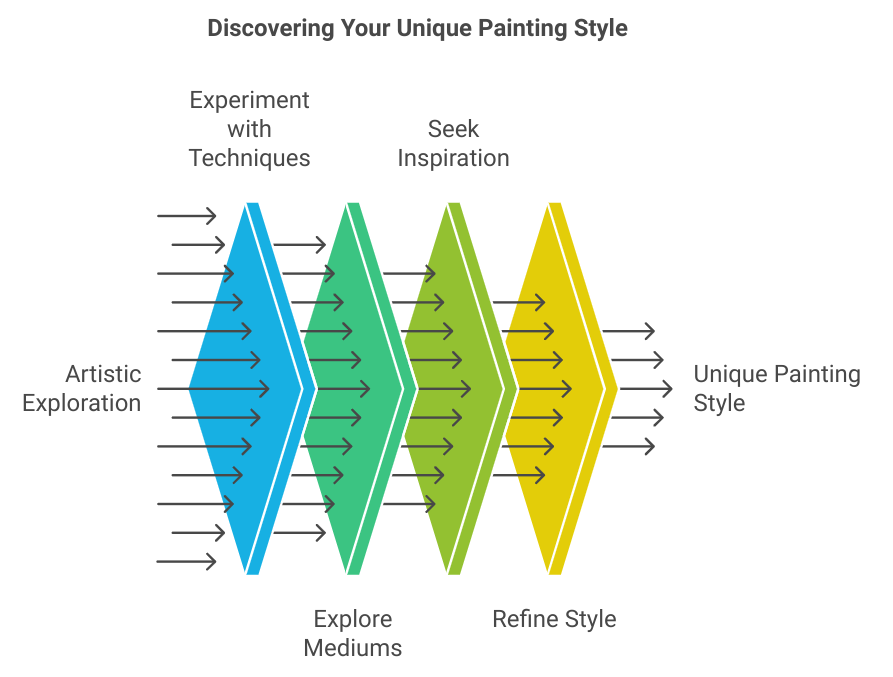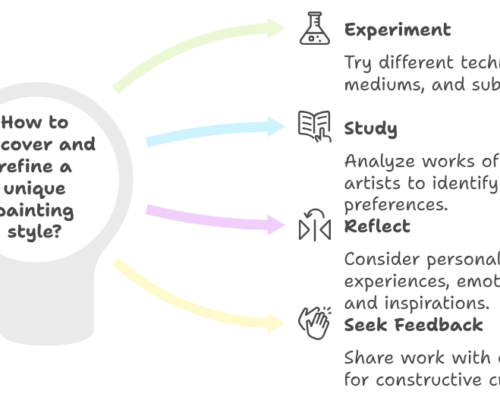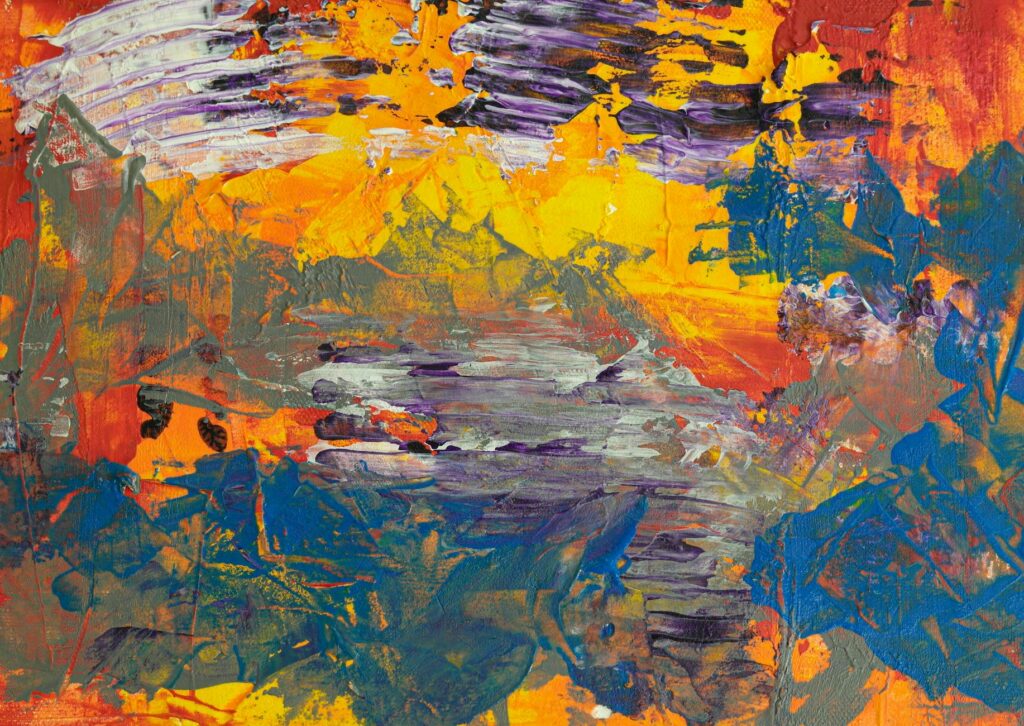Finding Your Niche in a World of Brushes and Colors
As an aspiring or seasoned artist, navigating the vast expanse of artistic expression can be daunting. With countless techniques, mediums, and inspirations at your fingertips, pinpointing your painting style might seem like finding a needle in a haystack. But fear not, dear artist! This journey of self-discovery is a pivotal part of your creative evolution. In this comprehensive guide, we’ll delve into the practical steps and insightful tips to help you uncover, refine, and proudly claim your unique painting style.
Understanding the Concept of Painting Style
Before embarking on this creative quest, it’s essential to grasp what constitutes a painting style. Simply put, your painting style is the distinctive way you convey ideas, emotions, or subjects through your artwork. It’s a blend of your technical skills, personal preferences, and the emotional resonance you wish to evoke in your audience.
| Elements of Painting Style | Description | Reflective Questions |
|---|---|---|
| Technique | Brushwork, layering, texture | What techniques do I enjoy most? Are there any I’ve yet to explore? |
| Color Palette | Dominant colors, contrast, harmony | Are my choices bright and bold or muted and pastel? Why? |
| Subject Matter | Themes, genres (e.g., landscape, portrait) | What subjects do I return to? What do they signify to me? |
| Composition | Spatial arrangement, balance, focus | How do I lead the viewer’s eye through my work? |
| Emotional Resonance | Mood, atmosphere, intended impact | What emotions do I aim to evoke with my art? |
Step-by-Step Guide to Discovering Your Painting Style
1. Explore and Experiment
- Dabble in Different Mediums: From watercolors to acrylics, each medium has its unique challenges and expressive qualities. Discover which one(s) resonate with you the most.
- Technique Trials: Engage with various techniques. You might find solace in the smoothness of glazing or the textured appeal of impasto.
- Subject Matter Safari: Venture through genres. Sometimes, what we think we’ll enjoy isn’t where our true passion lies.
2. Study the Masters and Contemporaries
- Artistic Lineage: Understand the evolution of art movements. Identifying with aspects of different styles can guide you toward your own.
- Contemporary Inspiration: Follow living artists whose work resonates with you. Analyze what specifically draws you to their painting style.
3. Reflect and Identify Patterns
- Art Journaling: Document your journey. Note what you enjoyed about each piece, what challenged you, and the outcomes.
- Pattern Recognition: After several projects, reflect on your journal. Are there recurring themes, colors, or techniques? These are clues to your emerging painting style.
4. Refine and Be Patient
- Focus on Your Strengths: Once patterns emerge, concentrate on refining those aspects. Practice is key to mastery.
- Evolution is Natural: Your painting style will grow and possibly change over time. This is a sign of artistic growth, not inconsistency.
5. Seek Feedback and Community
- Critique Sessions: Engage with fellow artists or mentors for constructive feedback. Sometimes, others can pinpoint your unique traits before you do.
- Artistic Communities: Join online forums or local art groups. Sharing your work and seeing others’ can provide invaluable insights and motivation.
Embracing Your Unique Painting Style

Claiming Your Artistic Voice
Finding your painting style isn’t a destination; it’s a journey of discovery and continuous evolution. It’s about embracing what makes your art uniquely yours, whether that’s the bold expressiveness of abstracts, the serene depth of landscapes, or the captivating intimacy of portraits.
- Celebrate Your Differences: What sets you apart is also what will draw your audience to you.
- Stay Curious, Keep Creating: The moment you feel fully defined is the moment to challenge yourself again. Growth and exploration are lifelong companions to a thriving artist.
Masters Finding their Unique Style
| Painter | Unique Style Description |
|---|---|
| Leonardo da Vinci | A master of the Renaissance, Leonardo da Vinci is known for his innovative techniques such as sfumato, which blends colors and tones for soft transitions and realistic effects, and linear perspective to create depth. His works capture human emotion and complex compositions, reflecting a profound understanding of anatomy and nature. |
| Vincent van Gogh | Known for bold, dramatic brushstrokes, expressive use of color, and a profound connection to nature and humanity. His paintings convey emotional depth and movement, using vibrant palettes to express feelings rather than accurately depict subjects. |
| Pablo Picasso | Pablo Picasso pioneered Cubism, known for breaking objects into geometric shapes, using layered colors and textures to create abstract forms that explore structure and multiple viewpoints simultaneously. His techniques also included collage, marking a shift in the conception of art from mere representation to a complex play of signs and symbols. |
| Claude Monet | A pivotal figure in the Impressionist movement, known for his loose brushwork, vibrant use of color, and dynamic depictions of natural light. Monet frequently painted the same scene under different lighting conditions, as evident in his series of haystacks and water lilies, emphasizing the fleeting quality of nature. |
| Frida Kahlo | Frida Kahlo’s work blends surrealist elements with Mexican folk art, characterized by vivid colors and symbolic representations of identity, pain, and femininity. Her self-portraits explore personal and cultural themes, often addressing her struggles with health and identity. |
| Andy Warhol | Pioneer of Pop Art known for vibrant silkscreen techniques, repetition, and exploration of consumer culture and celebrity. |
| Henri Matisse | Leader of the Fauvist movement, known for bold, non-naturalistic colors, simplified forms, and emotional expression through color rather than realistic representation. |
| Jackson Pollock | Jackson Pollock’s style is defined by action painting, particularly his drip technique where he poured or splashed paint onto large canvases placed on the floor, enabling him to view and paint from all angles. His work emphasizes spontaneity and physicality, using unconventional tools and reflecting influences from primitive cultures such as Native American sand painting. This method has marked a significant impact on abstract expressionism. |
| Salvador Dalí | Known for his surrealism and symbolism, Dalí utilized the paranoiac-critical method to induce irrational thoughts, creating bizarre, dream-like images that explore themes of time and decay, epitomized by his melting clocks. |
| Georgia O’Keeffe | Known for her large-format paintings of natural subjects, especially flowers and desert landscapes, Georgia O’Keeffe emphasized the essential elements of art such as line, color, and composition, often depicting subjects in a close-up, abstracted manner that reveals the extraordinary in the everyday. |
| Paul Cézanne | Known for constructing images with discrete brushstrokes, using color and form to create depth; influenced the transition from Impressionism to Cubism. |
| Rembrandt van Rijn | Master of light and shadow, known for chiaroscuro techniques, dynamic interplay of light and dark, innovative brushwork, and deep emotional portrayals that capture complex human emotions. |
| Wassily Kandinsky | Pioneer of abstract art, combining vibrant colors and shapes to express inner emotions; explored the relationship between color and sound, influencing movements like Expressionism and the Blue Rider group |
| Edvard Munch | Expressive style characterized by intense colors, semi-abstraction, and themes of anxiety, love, and death, influenced by Impressionism and later becoming a key figure in Expressionism |
| Joan Miró | Combines elements of Surrealism and abstraction, characterized by whimsical, childlike forms and vivid colors. Notable for using organic shapes, his work reflects a playful, dreamlike quality, created through automatic drawing techniques that manifest his subconscious. Miró’s compositions balance spontaneity and deliberate structure, contributing significantly to modern art. |
Conclusion
Uncovering your painting style is a deeply personal and creatively rewarding process. Through exploration, reflection, and a willingness to evolve, you’ll not only find your artistic voice but also enrich the diverse tapestry of the art world with your unique perspective.
Remember, your painting style is a journey, not a jackpot—it’s in the creating, experimenting, and loving the process that you truly find your artistic self.
Call to Action: Share your journey of discovering your painting style with us! What challenges did you face, and what exciting breakthroughs did you experience along the way? Let’s grow and inspire each other in the comments below



